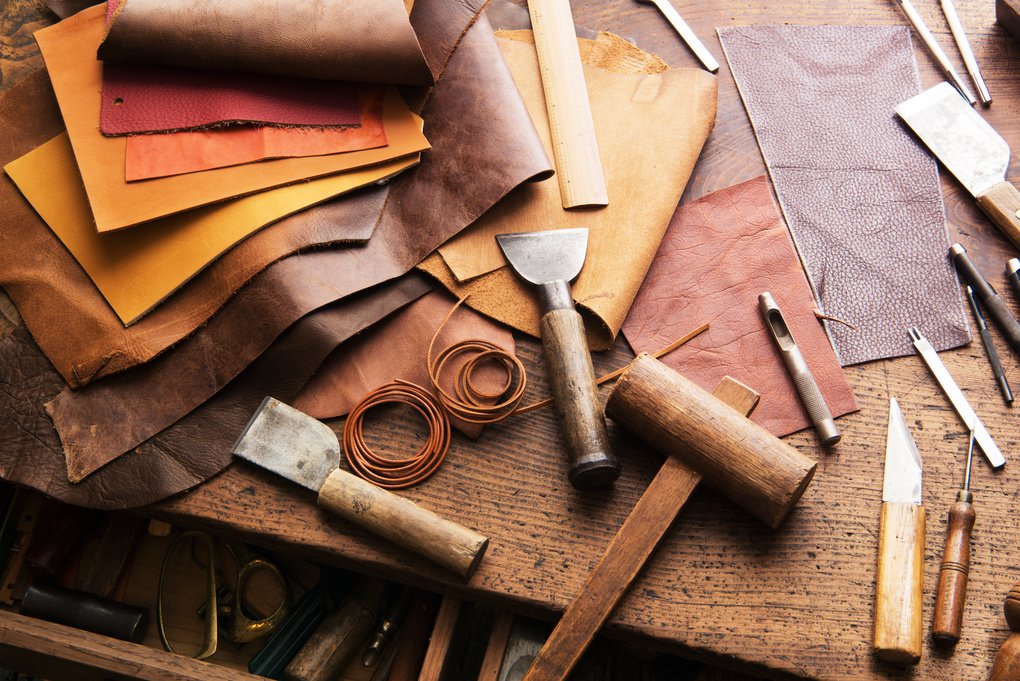Choosing Leather Cutting Tools that Make the Cut

Leather cutting tools play a central role in the leather crafting process. They not only contribute to the pleasure—or pain—of the process, but also to the quality of the finished product. The first place to start is to determine what cutting tools are needed.
Leathercraft Tools: The Cutters You Need
Two must-have cutting tools for leather are a utility knife and a smaller hobby or craft knife. Additional common leather cutting tools include the following:
- rotary cutters (think really sharp pizza cutter)
- heavy-duty scissors
- head knives
- swivel knives
- hole punches
- skiving knives
- V-gouge knives
How to Find the Best Leather Cutting Tools
The most critical aspect of any leather cutting tool is that it has to be effectively sharp. Or, in the words of JD Tagish in his article “Introduction to Leatherworking”: “A leather worker’s most dangerous tool is a DULL KNIFE. The more dull the knife, the more pressure you put down to cut through, and although that knife may be dull when cutting leather, pushing down hard on it it will cut your fingers VERY WELL!” (All capitals in original; that’s how serious he is.)
Dull leather cutting knives also don’t cut leather cleanly, leaving ugly, uneven jagged edges. Unless you purchase a burnishing machine, which finishes off those edges, expect to spend a good amount of time hand burnishing.
It is critical then with metal-bladed cutting tools that you can either sharpen the blade frequently or replace it, as metal dulls quite quickly especially when used on tough materials like leather. How quickly?
Master leathersmith Joshua Watts says that he goes through roughly a blade a day. Sometimes even more. He also notes that because of the pressure needed to get a blade through leather, the tip of the blade often breaks off.

Watts’ interest was piqued when he learned about Slice® cutting tools, which feature ceramic blades that stay sharp 11 times longer than metal blades. But he was skeptical: Slice’s advanced and proprietary design resists cutting skin. That made Watts wonder: “If it resists cutting skin, is it going to cut leather?” Good question!
Slice Ceramic Blades Make Great Tools to Cut Leather
The answer to Watts’ question was a resounding yes. After having used Slice products for about one month, Watts has become a particular fan of the Craft Knife and the Manual Box Cutter. The former he likes for detail work: “I use it all the time,” says Watts. “It’s way rad!”
The Slice Manual Box Cutter, which is part of the Slice lineup of box cutters, Watts likes for cutting long lines through a large piece of leather. He notes that this is what he has traditionally used his rotary cutter for. He prefers the box cutter because it can also make curves, while the rotary cutter can only cut straight. This translates to him wasting less leather and thereby saving money, as leather can be expensive.
In terms of durability, Watts says he hasn’t changed a blade yet—after daily use for a month. He also found some features of the Slice blade that make it Ideally suited to leather in particular.
First, the stiffness. Where metal blades bend slightly when cutting material like leather, Slice blades don’t. This provides cleaner edges (read: less time burnishing) and more control. Watts also noticed that Slice blades require less pressure. “The blade seems to glide through the leather,” he says.
Safety and Your Leather Cutter
Previous to trying Slice cutters, Watts wasn’t aware of their leather-friendly attributes. What initially drew him to the product was the finger-friendly® blade design: “What got my attention is the fact that the blades resist cutting skin,” he says.
Cutting through leather, like any pursuit that requires sharp blades, is dangerous. And while dull blades are a leather crafter’s worst tool, sharp metal blades are, well, really sharp! There is more to safety cutting than just cutting safely. Slice looks at knife safety and the risks posed by knives from many different perspectives, realizing that merely redesigning the tool handle won’t mitigate the risks inherent in the blade. By using 100% zirconium oxide for our blades, we can manufacture our safety blades with finger-friendly blade edges and shorter initial cutting zones, resulting in a safer blade that is much less likely to cause a laceration if there is an accidental slip of the worker’s hand or the tool itself.
Watts once almost took his thumb off using a rotary blade, and regularly sustains cuts. “Safety is a big deal,” he says.
With metal blades, there isn’t just the concern of getting cut when using them. You also have to use caution when changing or sharpening a blade. Other considerations include the time it takes to sharpen metal blades and the cost to replace them. The rotary blade stands out here. Metal replacement blades are relatively expensive, so hand sharpening becomes appealing. But this is a dangerous prospect as there is no particularly safe way to hold a rotary blade for sharpening.
However you slice it, a leather cutter that keep its edge longer, is resistant to cutting skin, and cuts cleanly through leather sound quite appealing. Slice ceramic cutters solve several problems commonly associated with leather cutters, and adding them to your kit of leather cutting tools is a natural fit.
Further Reading:
